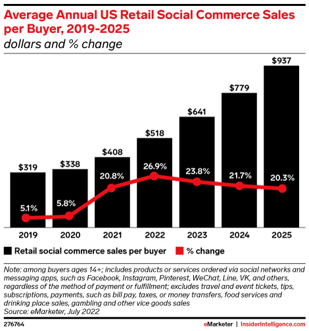What’s Shaping the eCommerce Landscape?
In the dynamic realm of online commerce, the landscape is continually shaped by various influential factors. These elements not only dictate the current state of affairs but also pave the way for future trends and developments. Understanding what's driving these changes is crucial for businesses striving to thrive in the competitive eCommerce arena.
From technological advancements to shifting consumer behaviors, the forces at play in eCommerce are multifaceted and ever-evolving. Let's delve into some of the key drivers shaping the eCommerce landscape.
Trend 1: Omnichannel Expansion
Omnichannel expansion is a trend that highlights the growing importance of providing a seamless shopping experience across multiple channels. It recognizes that consumers interact with brands through various touchpoints, including websites, mobile apps, social media platforms, and physical stores. As a matter of fact, 73% of consumers utilize multiple channels during their shopping journey while making a purchase decision. eCommerce businesses are increasingly adopting an omnichannel approach to meet the evolving preferences and expectations of customers.
Implementing omnichannel strategies requires investment in technology and infrastructure to ensure seamless integration and synchronization across channels. This may involve adopting a unified customer relationship management (CRM) system, inventory management software, and robust data analytics tools. By leveraging data insights from various channels, businesses can better understand customer behavior and preferences, allowing for more targeted marketing campaigns and personalized interactions. Companies with strong omnichannel strategies in place on average retain 89% of their customers, so as an eCommerce brand, it is crucial to consider an omnichannel expansion strategy.
Ultimately, omnichannel expansion enables eCommerce businesses to enhance customer satisfaction, improve brand loyalty, and drive revenue growth. By meeting customers where they are and providing a frictionless shopping experience across channels, businesses can stay competitive in today's rapidly evolving eCommerce landscape.
Trend 2: The Rise of Social Commerce
The rise of social commerce marks a significant convergence of social media and eCommerce, transforming how consumers discover, engage with, and purchase products online. In fact, 54% of social media users use different social platforms to conduct product research prior to making a purchase, and 71% are more likely to make a purchase based on social media. Social media platforms have evolved beyond being mere networking tools; they have become powerful sales channels where brands can directly connect with customers and facilitate transactions.
 Social commerce sales per buyer are expected to reach $779 this year, a 21.7% increase from 2023, as can be seen in the graph to the left. Social commerce encompasses various features and functionalities that enable seamless shopping experiences within the social media environment. Shoppable posts, for example, allow brands to tag products in their social media posts, enabling users to purchase items directly without leaving the platform. Live shopping events, where brands livestream product demonstrations and promotions, create interactive and engaging shopping experiences for audiences.
Social commerce sales per buyer are expected to reach $779 this year, a 21.7% increase from 2023, as can be seen in the graph to the left. Social commerce encompasses various features and functionalities that enable seamless shopping experiences within the social media environment. Shoppable posts, for example, allow brands to tag products in their social media posts, enabling users to purchase items directly without leaving the platform. Live shopping events, where brands livestream product demonstrations and promotions, create interactive and engaging shopping experiences for audiences.
Leveraging social commerce offers numerous benefits, including expanded reach, increased brand visibility, and higher conversion rates. By tapping into the social networks of their target audience, brands can amplify their marketing efforts and drive traffic to their eCommerce platforms. Moreover, social commerce facilitates direct communication and engagement with customers, fostering relationships and building brand loyalty.
As social commerce continues to gain momentum, eCommerce businesses must adapt their strategies to capitalize on this trend. This involves creating compelling and visually appealing content, optimizing product listings for social media platforms, and leveraging influencer partnerships to reach and resonate with target audiences. By embracing social commerce, brands can unlock new opportunities for growth and success in the competitive eCommerce landscape.
Trend 3: Mobile Commerce
Mobile commerce refers to the buying and selling of goods and services through mobile devices such as smartphones and tablets. With the widespread adoption of mobile technology and the increasing reliance on smartphones for everyday tasks, mobile commerce has become a dominant force in the eCommerce landscape.
Global mobile eCommerce sales made up 60% of all eCommerce sales in 2023. To capitalize on the opportunities presented by mobile commerce, eCommerce businesses must ensure that their websites and apps are fully responsive and optimized for mobile devices. This includes implementing mobile-friendly design principles, optimizing page load times, streamlining the checkout process, and providing intuitive navigation and search functionality.
In addition to optimizing the shopping experience, mobile commerce also opens up new avenues for customer engagement and marketing opportunities. Push notifications, in-app messaging, and location-based targeting enable eCommerce brands to deliver targeted promotions, personalized recommendations, and real-time updates to users' mobile devices, driving engagement and increasing conversion rates. As a matter of fact, push notifications can result in up to a 16% increase in in-app purchases.
By prioritizing mobile optimization and embracing mobile commerce trends, eCommerce businesses can tap into the vast potential of the mobile market, reach a wider audience, and drive revenue growth in today's digital-first world.
Trend 4: Sustainability and Ethical Shopping
Sustainability and ethical shopping have emerged as prominent trends in the eCommerce world, driven by increasing consumer awareness of environmental and social issues and a growing demand for products and brands that align with their values.
Consumers today are more conscious than ever about the environmental and social impact of their purchasing decisions. They are seeking out brands that demonstrate a commitment to sustainability, ethical sourcing, and responsible business practices.
One of the key aspects of sustainability and ethical shopping in eCommerce is sustainable sourcing and production. 66% of US consumers are willing to pay more for a product if it’s sustainably sourced, making it vital for brands to focus on sustainability for their products. Another important aspect of sustainability in eCommerce is reducing the environmental impact of packaging and shipping. Additionally, optimizing logistics and transportation processes can help reduce emissions associated with shipping and delivery.
By aligning with the values and priorities of their customers, eCommerce brands can build trust and credibility, differentiate themselves in the market, and drive long-term success and sustainability.
Trend 5: Artificial Intelligence & Augmented Reality
Artificial intelligence (AI) and augmented reality (AR) are two transformative technologies reshaping the eCommerce landscape, revolutionizing how businesses interact with customers and deliver immersive shopping experiences.
AI plays a crucial role in eCommerce by powering personalized recommendations, predictive analytics, chatbots, and virtual assistants. By analyzing vast amounts of data, AI algorithms can understand customer preferences, anticipate their needs, and deliver tailored recommendations and offers. In fact, by 2035, AI is projected to increase business productivity by at least 40%. This enhances the shopping experience, increases engagement, and drives conversion rates for eCommerce businesses.
Augmented reality (AR) technology enables eCommerce businesses to create immersive and interactive shopping experiences that bridge the gap between online and offline retail. 61% of consumers state that they prefer shopping at stores that offer AR over those that do not. AR applications allow customers to visualize products in their physical environment before making a purchase, such as trying on virtual clothing or previewing furniture in their home. This enhances product understanding, reduces purchase hesitation, and increases confidence in buying decisions.
By harnessing the power of AI and AR, eCommerce businesses can unlock new opportunities for growth, innovation, and customer engagement. Whether it's delivering personalized recommendations, providing virtual product experiences, or offering seamless customer service, AI and AR have the potential to revolutionize the eCommerce industry and shape the future of online retail.
In conclusion, thriving in the ever-evolving landscape of eCommerce demands a proactive approach from brands. Embracing innovation, adapting to shifting consumer behaviors, and capitalizing on emerging trends are crucial steps for success.
Understanding these trends' significance and implementing effective strategies are paramount for sustainable growth and success in eCommerce. Whether by diversifying onto new platforms, crafting compelling content, or collaborating with influencers, brands must remain agile, customer-centric, and poised to outpace the competition.
More About aiCommerce
aiCommerce is a global digital marketing agency with a focus on retail and eCommerce marketplaces. aiCommerce can help your brand grow across eCommerce channels to gain brand awareness, visibility, and increase sales, all backed by our 90-day guarantee. Now is the perfect time to utilize our eCommerce experts to help grow your business. Click the button below to qualify for a free listing audit to jumpstart your eCommerce growth!




